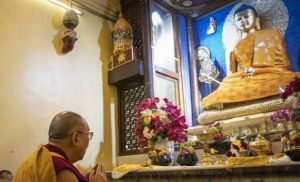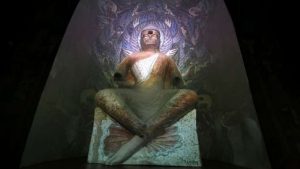I, the layman Buyančog Bagši with sincere belief in the Three Jewels, firstly thinking and reflecting on the virtues of the Buddhas; secondly that the merit may reach both of my blessed ones, my mother and my father; and thirdly with the thought that all of my wishes for welfare in the present time may be fulfilled and that later I will escape from the sufferings of samsara through the vehicle of Buddhahood. . .
Uyghur blockprint, 1308 (Elverskog 2024, 132)

Columbia University Press’s A History of Uyghur Buddhism (2024) is like a long-awaited homecoming. For decades, Buddhist studies scholars and interdisciplinary specialists have come across this mysterious yet seemingly omnipresent community of “Uyghur Buddhists” in Dunhuang studies, Sinology, Silk Road studies, and much more. Author Johan Elverskog is one of the most prominent names in the study of Buddhism in Central Asia and now brings the singular voice of Uyghur Buddhism to life. This is their story, for the first time.
Such deep-rooted connections between the Uyghurs and Buddhism might seem surprising even to Buddhists, let alone the lay reader who would commonly associate Uyghurs with Islam. That is why the historical stakes are high. From the introduction, Elverskog writes:
The Uyghurs, however, provide an especially good opportunity to connect Buddhism to Asian history because they resided at the center of Eurasia and linked multiple worlds: China and the West, the steppe and the sown, China and Tibet, as well as the Buddhist and Muslim worlds. (4)
Furthermore, Elverskog notes that the 13th and 14th centuries were such apogees of Buddhist development that the Uyghurs enjoyed a kind of soft power in Buddhist Tibet, where Tibetans theorized that the Uyghur region was the mythical Shambhala. Economics, geopolitics, climate change, and technological innovation all played important and complex roles in the establishment and decline of Buddhism in the Uyghur civilization.
The book is structured into five chapters: “Becoming Buddhist,” “Buddhist Politics,” “Buddhist Economics,” “Uyghur Buddhisms,” and “Becoming Muslim.” This is a chronological, thematic treatment of the Buddhist history among the Uyghur Turkic people, from rise to fall—or Islamicization. It is ideally compact and neatly woven into a coherent, unbiased but sympathetic historical narrative.

There are some core points that worth lifting out of the book, which are soon going to be commonly known points for Buddhist historians. Firstly, Chinese sources record that Buddhist missionaries were moving among Turkic communities during the First Turk Empire (552–612 CE). (6–7) The Uyghur adoption of Buddhism proper came later, with complex political maneuvering between the Manichean Sogdians, Tibetans, and Chinese eventually resulting in an equally complex diaspora of Uyghurs, two streams of which resulted in the three dynasties of the Guiyijun Kingdom, the Ganzhou Uyghur Kingdom, and the West Uyghur Kingdom. The primary demographics of Uyghur converts to Buddhism (who became Buddhist quite gradually) were primarily the royal elite and the wealthy mercantile class. They were a minority ruling over: “Chinese Buddhists, Khotanese Buddhists, Sogdian Buddhists, Tokharian Buddhists, Tibetan Buddhists, and others.” (17) Buddhist scriptures were localized and translated into Uyghur in Brahmi, Tibetan, and Sogdian script.
Elverskog is of the scholarly opinion that Uyghur for one simple reason come the medieval year of 1000—and in fact, rather than fearing the Islamic Qarakhanids, he thinks that the Uyghurs had more to fear from the expansionist Buddhist Tangut Empire (24)—everyone was doing it; there was a continent-wide turn toward Buddhism across many empires and states. (27) Uyghur ties to these empires, including the three-way conflict between the Khitan Liao, the Chinese Song, and the Tanguts meant that Buddhism became a political, cultural, artistic, and economic unifier across East Asia, with the Uyghurs joining in amid this interconnected ecosystem.
The author brings to life too many threads of the Uyghur story to list comprehensively here. For example, he highlights how the “golden age” of Uyghur Buddhism came about with Mongol involvement, and through the power of the khan, an end to the “freewheeling and eclectic nature of Uyghur Buddhism” in the 13th and 14th centuries, transforming into a component of the Mongol imperial project. (122) Uyghur Buddhism became, on top of a tantric tradition since its involvement in Dunhuang and among the Liao, focused on Manjushri and Wutaishan. The Pax Mongolica led to an expansion and consolidation of lay rituals and scholarly translations that Elverskog highlights.
Chapter 5, “Becoming Muslim,” touches on a sensitive topic that is still subject to misunderstanding, exaggeration, and polemics even today. Just as the Uyghur conversion to Buddhism was gradual, as was the Uyghur abandonment of Buddhism and assimilation of Islam. This was facilitated in no small part by the Uyghur engagement with Central Asian Muslims, and as they were the steppe intelligentsia of the Mongol Empire, they pushed Buddhism into the heart of the Islamic world, which led to a rich, two-way mutual influence of philosophical, cultural, and theological exchange. Later Muslim historians would be “mortified into silence” about these results. (141)
A fragmenting of an already diverse and divided Mongol Empire led to a long, slow road to Islamicization. Although views of Islam in the Kalachakra Tantra influenced negative Buddhist conceptions of Islam (156–57), Elverskog’s view is that Islam simply offered a competitive theology, economic structure, and network of sacrality that was sufficiently enticing to Uyghur elites. (168–69) As he writes:
Of course, it is on the macro level that historians and scholars of religion try to explain events and to paint a convincing portrait of what ‘actually happened’ through a logical chain of cause and effect. Although such narratives are often admirable and useful, they also often lead to simplistic and monolithic explanations that obscure the very complexities they are trying to explain. (169)
In many monographs and research projects that span Buddhist history, a scholarly consensus has emerged that the “core” of Central Eurasia was critical to the shaping of the Buddhist politics, economies, and cultures of “peripheral” sedentary empires that underwent Buddhist diffusion. As for the Central Eurasian cultural complexes, they range from variously categorized steppe, nomadic, semi-sedentary, and sedentary communities. But they also were intimately part of broader ecological, political, and military realignments that connected them to other cultures and civilizations across the Eurasian continent. Like Indra’s web, the interconnected nature of Buddhism’s rise and fall among these Central Eurasian peoples, including the Turks and Uyghurs, means that the Buddhist story is truly transcontinental and multi-ethnic.
Elverskog has produced a beautifully no-frills, understatedly direct writing style charting the Uyghur contribution to Buddhism. His story of the Uyghur Buddhists is, without exaggeration, a delight to read that will be hard to replicate for some years to come. It will take a scholarly work of similar comprehensiveness and simultaneous readability to surpass his work here.
References
Elverskog, Johan. 2024. A History of Uyghur Buddhism. New York: Columbia University Press.
Related features from BDG
Buddhistdoor View: Unfinished Dispensation – The Search for Buddhist Authenticity in China
The Lotus-Born One
Buddhistdoor View: The International Dunhuang Programme and Digital Tech as the Guardian of Ancient Heritage
Tibet on the Silk Road from a Curator’s Eye: An Exhibition Tour with Dr. David Pritzker
Echoes of Indian Buddhist Culture in China: An Interview with Prof. Shashi Bala, Part One













